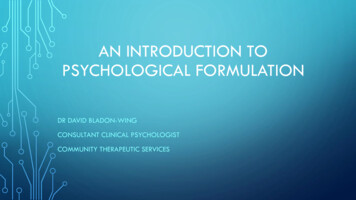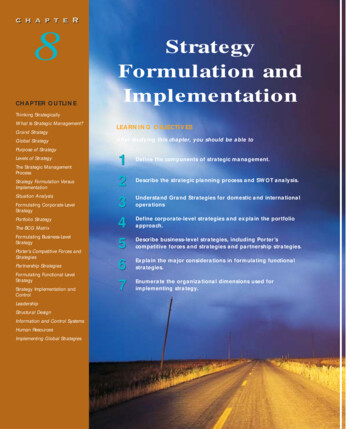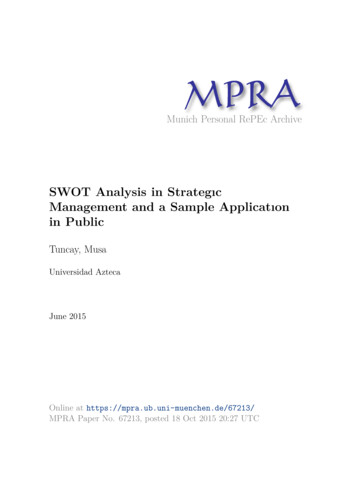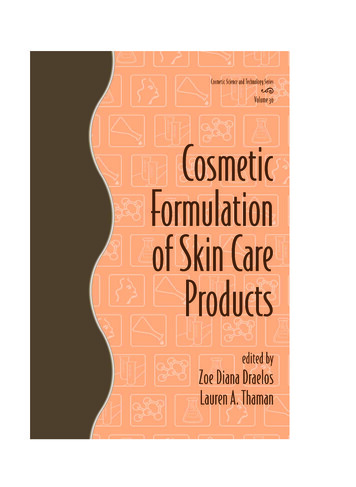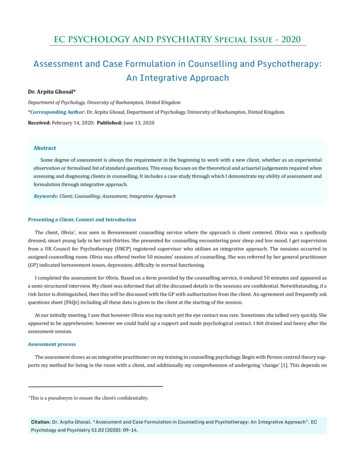
Transcription
EC PSYCHOLOGY AND PSYCHIATRY Special Issue - 2020Assessment and Case Formulation in Counselling and Psychotherapy:An Integrative ApproachDr. Arpita Ghosal*Department of Psychology, University of Roehampton, United Kingdom*Corresponding Author: Dr. Arpita Ghosal, Department of Psychology, University of Roehampton, United Kingdom.Received: February 14, 2020; Published: June 13, 2020AbstractSome degree of assessment is always the requirement in the beginning to work with a new client, whether as an experientialobservation or formalised list of standard questions. This essay focuses on the theoretical and actuarial judgements required whenassessing and diagnosing clients in counselling. It includes a case study through which I demonstrate my ability of assessment andformulation through integrative approach.Keywords: Client; Counselling; Assessment; Integrative ApproachPresenting a Client: Context and IntroductionThe client, Olivia1, was seen in Bereavement counselling service where the approach is client centered. Olivia was a spotlesslydressed, smart young lady in her mid-thirties. She presented for counselling encountering poor sleep and low mood. I get supervisionfrom a UK Council for Psychotherapy (UKCP) registered supervisor who utilizes an integrative approach. The sessions occurred inassigned counselling room. Olivia was offered twelve 50 minutes’ sessions of counselling. She was referred by her general practitioner(GP) indicated bereavement issues, depression, difficulty in normal functioning.I completed the assessment for Olivia. Based on a form provided by the counselling service, it endured 50 minutes and appeared asa semi-structured interview. My client was informed that all the discussed details in the sessions are confidential. Notwithstanding, if arisk factor is distinguished, then this will be discussed with the GP with authorization from the client. An agreement and frequently askquestions sheet (FAQs) including all these data is given to the client at the starting of the session.At our initially meeting, I saw that however Olivia was top notch yet the eye contact was rare. Sometimes she talked very quickly. Sheappeared to be apprehensive; however we could build up a rapport and made psychological contact. I felt drained and heavy after theassessment session.Assessment processThe assessment draws as an integrative practitioner on my training in counselling psychology. Begin with Person centred theory sup-ports my method for being in the room with a client, and additionally my comprehension of undergoing ‘change’ [1]. This depends onThis is a pseudonym to ensure the client’s confidentiality.1Citation: Dr. Arpita Ghosal. “Assessment and Case Formulation in Counselling and Psychotherapy: An Integrative Approach”. ECPsychology and Psychiatry SI.02 (2020): 09-14.
Assessment and Case Formulation in Counselling and Psychotherapy: An Integrative Approach10Rogers ‘six necessary conditions for personality change’ [1]. Rogers contends that these conditions, given by the therapist, are sufficientto enable an individual to being their “real self “and to steadily move to ‘flowingness of experience’ from ‘fixity of experience’ [1]. In theassessment, I pose six question set out by Wilkins and Gill [2] in view of Rogers’ six sufficient and necessary conditions. In the event thatI can answer yes to these questions, I realize that there is potential to shape a therapeutic relationship with the client.Classic person-centred practitioners and theorists contend that assessment runs counter to client centred practice due to the fact thatby it’ this is a pseudonym to ensure the client’s confidentiality. Exceptionally nature evaluation includes putting a judgment on the clientand the therapeutic relationship [3]. Nevertheless, as I think an assessment can be led in a way that grasps the person hood of the clientsand can possibly coordinate the individual back towards their actualising inclination.I had acclimatized [4] components of psychodynamic theory into this person-centred base to illuminate my reasoning. Psychoanalyticthoughts seemingly make uneasy associates with person-centred philosophy. Formulation is imperative to psychodynamic practitioners[5], while it is shunned by client-centred therapists. Psychodynamic theory puts the practitioner in a “specialist” position where they cancommunicate and understand the client’s unconscious procedures, while client centred practitioners assert that the client recognizeswhat they require. However, Kahn (1997) contends that these thoughts can be united by empathy.I had absorbed cognitive behavioural therapeutic thoughts into assessment model. A CBT specialist utilizes an assessment, collabo-ratively with the client, to formulate and make a treatment plan for that client [6]. CBT strategies, for example, ‘Goal setting now forms’had been a part of my assessment model.The utilization and consciousness of the therapeutic relationship is principal to my practice. By utilizing Clarkson’s [7] relationshipmodel, this can be conceptualized. Yalom [8] affirms that ‘it is the relationship that heals’. The meeting of two individuals in a therapeuticexperience encourages change [7]. Inside the conditions of the working alliance, it is essential to considering potential harm to the otheror self-assess for risk and to contract in like manner.I have likewise incorporated practices from my present setting, e.g. the utilization of FAQs about the service and the utilization ofClinical Outcomes in Routine Evaluation - Outcome Measure (CORE-OM) [9] forms toward the start and the finish of therapy. I offer theform cooperatively to avoid the client embarrassed feeling if she finds it difficult.Presenting issues and diagnosisOlivia’s behaviours and symptoms were reliable with a DSM-5 [10] finding of “Major Depressive Disorder, Single Episode, Mild, withanxious distress, Mild” (296.21/311). Initially I considered a comorbid diagnosis of GAD (300.2), nonetheless, Olivia’s symptoms ap-peared to be more with regards to specifiers for anxious distress as she regularly felt tense and had a fear, particularly at night thatsomething bad would happen to either herself or one of her nearby relatives.Her symptoms had been existent for more than 5 months. She detailed feeling “sad and low” and all through the session was tearful.She had lost her interest in hobbies of baking and sewing since she felt she couldn’t get them right. She encountered insomnia. She re-ported feeling ‘substantial’, lacking energy, regularly feeling she was sufficiently bad and not able to get things right. She had periodiccontemplations that things ‘would be better if she wasn’t there’ yet portrayed them as brief and she could never follow up on them. Herlack of energy was affecting her relationship with her family and husband. She announced feeling ‘substantial’, lacking energy, regularlyfeeling she was sufficiently bad and not able to get things right. She had periodic contemplations that things ‘would be better if she wasn’tthere’ yet portrayed them as brief and she could never follow up on them. Her lack of energy was affecting her relationship with her family and husband. She felt that her work performance was enduring. While she was bothered by these symptoms, she was unable to function like before. I observed that she was very still during the session. These observations were predictable with criteria A1, A2, A4, A5,Citation: Dr. Arpita Ghosal. “Assessment and Case Formulation in Counselling and Psychotherapy: An Integrative Approach”. ECPsychology and Psychiatry SI.02 (2020): 09-14.
Assessment and Case Formulation in Counselling and Psychotherapy: An Integrative Approach11A6 and A7. She was not taking any medication or experiencing some other restorative condition to which the condition could be credited.She didn’t have any of the disorders recorded in section D and had never had a hypo-manic or manic episode as recorded in section E.A meta-analysis [11] analysed the adequacy of depressive disorder’s psychological treatments. Seven sorts of psychological treatmenttested were more valuable than being on the waiting list. This review likewise highlighted the requirement for more worldwide investigations of depression as the greater part of the reviews included occurred in the West. Chilvers [12] found in a randomized trial that12 months’ post-treatment ‘generic counselling’ was as viable as ‘medication treatment’, and patients favoured counselling. The absenceof specificity about the kind of counselling gave was a shortcoming in this review. Recommended by NICE guidelines, CBT therapy asopposed to medications for mild depression.At the starting, Olivia’s score for level of general distress was 24.3, demonstrating a low level of distress contrasted with a UK clinicalpopulation. Olivia’s score is comparable on this scale as she is British. Her CORE-OM scores indicated she was enduring a low level ofdistress.Protective factors of the clientOlivia reported that her close friend is very supportive and when she is distress she can rely on her. Olivia also reported that on week-end she go for church services where she feels very relaxed. Sometimes a long walk also helps her to refresh her mood.Formulation: Relational deficits/traumaWhen I met Olivia, I discovered that her flawless presentation could be an outer cover to hide the sense of great disturbance that sheexperienced within herself [13]. In Rogerian rhetoric, she had created a negative belief about herself [1]. Her life was filled with a sense ofloss, uncertainty and fear, resulting in her feeling unwanted and not being loved and accepted by others, also the feeling of being rejectedand abandoned clinched her. She narrated a rigorous urge to comfort others and to undertake their own emotional journey, as well asperfectionism which disguised unconscious sentiments of vulnerability and embarrassment (Johnson, 1994).For Olivia, her story was of loss and death as she lost her first child due to miscarriage at just seventeen followed by the death of herbrother. Since her mother was truly depressed and couldn’t cope with her son’s premature death, she couldn’t herself mourn his deathwholeheartedly. Two months later, she lost her 4 year old daughter to cancer. Olivia felt like being rejected and depleted. Her explanationof her terrible losses from years ago showed a possibility that she was exposed to early relational trauma [14].Amongst siblings, Olivia was the eldest of her brother and sister. She said that her mother saw her as “a wonderful, quite, little babywho ate and slept well” and her younger sibling as the exact opposite. Her parents spent most of their time looking after her sister rightfrom her birth to teens. There is a possibility that Olivia understood very early in her childhood that being nice and quite led her to getconsent from elders whereas being troublesome did not (Rogers, 1990), conditions of worth. It is imaginable that she prepared herselfto hold onto her feelings, possibly if she sobbed, no one listened? This was a regular occurrence during her juvenile age when her sisterhad difficulties at school. Olivia had issues as well but couldn’t discuss it with her parents as she felt that they were already tackling hersister’s problems and were over-burdened by it. It seemed that Olivia oppressed her pains and dealt with it herself. It may be the casethat she did not get the required guidance and caring (Bion, 1962) that were essential to learn to balance her emotions. As we discussedher family, Olivia was so still that the motion lights in the room dimmed out. Her extreme stillness indicated that while talking about herextremely difficult experience, she firmly held her emotions. My supervisor said that Olivia was like a Swan who looked calm and composed on the outside but inside she was paddling at a brisk pace.It seems that Olivia uses suppression, projective assimilation and oppression to defend herself against this [15]. According to Freud,to get mastery over objects, we tend to repeat our previous experience in relationships [16]. Protrusion and separation are guards deCitation: Dr. Arpita Ghosal. “Assessment and Case Formulation in Counselling and Psychotherapy: An Integrative Approach”. ECPsychology and Psychiatry SI.02 (2020): 09-14.
Assessment and Case Formulation in Counselling and Psychotherapy: An Integrative Approach12ployed when someone is unreasonably hysterical position. In order to protect the good part of an admired object, the ‘Bad’ elements areseparated. May be that’s why she couldn’t accept the fact that she could be pained by her loved objects (baby and brother) by going awayfrom her and as a result she separated herself from these feelings of desertion, rejection and refusal from the ‘good, wonderful’ familymembers with whom she had experienced great proximity [17].At night, she feared that something nasty would happen to her or her near ones. This fear didn’t let her sleep at nights and might showthe ‘signal anxiety’ [18] which alerts us to not recognise the feelings underneath.It is possible that the circumstance of her becoming a mother capped back the pain that she couldn’t be a good mother to her latedaughter. “Am I capable of becoming a caring and loving mother? What will happen, if I am not? How will I take care of my future rela-tionship over the loss of my daughter? Can I think of having another baby in a relationship despite the memories of my late daughter?She was constantly experiencing a feeling of great agony, low mood and dejection because of the fact that her present was traumatisedby her unfortunate experiences of the past [19], this stopped her from communicating her thoughts wholeheartedly to her husband.Client’s goals from therapyWhat she desired from the therapy was to struggle out of her problems from the past and their repercussions on her current relation-ships, mainly her husband (Rogers, 1990) actualising tendency, and then use this to make her judgement if it’s wise to have another baby.Main relational experiences offeredThis person-centred understanding of Olivia’s journey of difficult times showed me that her present was still shadowed by her pastrelationships [20] and that her past life was filled with relational trauma and loss. This could possibly mean that my own model of working, as mentioned above, could probably be useful in making Olivia understand her past and with the help of containing (Bion, 1962)therapeutic relationship work through her losses. It is possible to accomplish the objective by having consistency of setting and timelimitations along with my capabilities as a professional therapist to understand her feelings, thoughts and projections and reflecting backto her in a way that she accepts them positively and making sure my own feelings are in check throughout the process [21].About my assessment, my model uses a humanistic approach for my counselling work in the room. Thus, Rogers’ core condition(Rogers, 1990) is the tool with which ‘accepts them positively ‘becomes possible in the room. This comprises the practice of empatheticreflection, depiction and the closeness to help establish her sense of self [22] and help her accept herself the way she is, while beinggenuine to myself [23-42].Conclusion and Possible InterventionsOlivia had been through so many losses in her life that left her feeling incomplete and raw. In our 12 sessions together, the subject of‘Death’ came up many a times. I believe this must have happened cause during the assessment I asked her about death [8]. This allowedher to discuss openheartedly her dreams of death and how she feared death. Initially, I was worried that she might find it too exhaustiveto discuss such a feeling whilst I was in the room, however while discussing transcript of the session with my supervisor, we noticed thatI had actually managed to open her up to explore a new level of feelings while discussing her own death.During my discussion with my supervisor after the assessment, I felt, I could have asked Olivia direct questions relating to her sexlife, concerning the indicator of depression. I could have established a greater understanding of her relationship with her husband andallowed myself to bring up the topic later in the therapy and see if she was comfortable discussing it. I did not ask her then, since didn’twant to come across as being too investigative. On looking back, I think this shows my own dilemma about the culture that I grew up inand hence did not bring sex topic into the room. Since then I have become more conscious about the significance of bringing forward suchCitation: Dr. Arpita Ghosal. “Assessment and Case Formulation in Counselling and Psychotherapy: An Integrative Approach”. ECPsychology and Psychiatry SI.02 (2020): 09-14.
Assessment and Case Formulation in Counselling and Psychotherapy: An Integrative Approach13topics more openly. I have discussed this in my personal therapy. My supervisor suggested that it wasn’t too late and I could ask her againif it came up. However, since the issue didn’t come up again, I thought it was more important to keep the session’s client led.Using Integrative approach while working in brief therapy at a bereavement service is something new for me. I have learnt how tomodify my approach of assessment while working in this approach and include the use of forms such as CORE-OM. The other contextI work in is open ended. This gives you time to ‘sit with feelings’ and let things come together. In short therapies, focus is key to carrywork forward and I think I managed to do this with Olivia since by the end of the whole therapy she was able to make a decision. Oliviadiscussed her feelings with her husband and also plans a baby later in life since she just lost her daughter.With the help of this report and after working with Olivia, I started valuing my own feelings, especially at the start of a relationship.I used both my work and personal therapy experience to understand and be aware of my own feelings and use it during my work withthe client. Moreover, Olivia shared some of my life experiences like I too had to go through an abortion due to my health issues. I realisedthat therapy and supervision were very important for having a very candid relationship with Olivia and her world without being bias(Spinelli, 2005). Exploring between utilizing my emotions and then additionally bracketing them is something I keep on working on.Bibliography1.Rogers CR. “On becoming a person”. London: Constable (0994).3.Mearns D. “Person-centred counselling training”. London: SAGE (1997).2.4.5.6.7.8.9.Wilkins P and Gill M. “Assessment in person-centered Therapy/Indikation und beurteilung in der personzentrierten Therapie/Evaluación en la terapiacentrada en la persona”. Person-Centered and Experiential Psychotherapies 2.3 (2003): 172-187.Messer SB. “Introduction to the special issue on assimilative integration”. Journal of Psychotherapy Integration 11.1 (2001): 1-4.Johnstone L and Dallos R. “Formulation in psychology and psychotherapy: making sense of people’s problems”. Hove: Routledge(2013).Westbrook D., et al. “An introduction to cognitive behaviour therapy: Skills and applications”. 2nd edition. London: SAGE (2011).Clarkson P. “The therapeutic relationship (2nd Edition)”. London: Whurr (2003).Yalom IDD. “Existential psychotherapy”. New York: Basic Books (1980).Evans C., et al. “Towards a standardised brief outcome measure: Psychometric properties and utility of the CORE-OM”. The BritishJournal of Psychiatry: The Journal of Mental Science 180 (2002): 51-60.10. American Psychiatric Association. Diagnostic and statistical manual of mental disorders (DSM-5 )”. Arlington: American PsychiatricPublication (2013).11. Barth J., et al. “Comparative efficacy of seven psychotherapeutic interventions for patients with depression: A network meta-analysis”. PLoS Medicine 10.5 (2013): e1001454.12. Chilvers C., et al. “Antidepressant drugs and generic counselling for treatment of major depression in primary care: Randomisedtrial with patient preference arms”. BMJ (Clinical Research Edition) 322.7289 (2001): 772-775.13. Winnicott DW. “On transference”. The International Journal of Psychoanalysis 37 (1956): 386-388.14. Khan MM. “The concept of cumulative trauma”. The Psychoanalytic Study of the Child 18 (1963): 286-306.15. Freud S. The unconscious 1915 collected papers 4 98-136 London (1925).Citation: Dr. Arpita Ghosal. “Assessment and Case Formulation in Counselling and Psychotherapy: An Integrative Approach”. ECPsychology and Psychiatry SI.02 (2020): 09-14.
Assessment and Case Formulation in Counselling and Psychotherapy: An Integrative Approach1416. Freud S. “Remembering, repeating and working-through (further recommendations on the technique of psycho-analysis II)”. Standard Edition 12 (1914): 145-156.17. Klein M. “Some theoretical conclusions regarding the emotional life of the infant”. The Writings of Melanie Klein 3 (1952): 61-93.18. Freud S. “Inhibitions, symptoms and anxiety”. Psychoanalytic Quarterly 5 (1963): 415-443.19. Freud S. “Mourning and melancholia”. The Psychoanalytic Review (1913-1957) 11 (1924): 77.20. Jacobs M. “The presenting past: the core of psychodynamic counselling and therapy”. Maidenhead: Mcgraw Hill (2012).21. Spurling L. “An introduction to psychodynamic counselling”. Hampshire: Palgrave Macmillan (2009).22. Mearns D., et al. “Person-centred counselling in action”. London: SAGE (2013).23. Barkham M., et al. “The Core-10: A Short measure of psychological distress for routine use in the psychological therapies”. Counselling and Psychotherapy Research 13.1 (2013): 3-13.24. Boseley S. “Psychiatric drugs do more harm than good, says expert”. The Guardian (2015).25. Byrne P. “Stigma of mental illness and ways of diminishing it”. Advances in Psychiatric Treatment 6 (2000): 65-72.26. De Angelo C. “Has anti-psychiatry raised any valid criticisms of the current state of mental illness treatment?” Quora (2016).27. Dziegielewski SF. “DSM-5 in action”. Hoboken, NJ: Wiley (2015).28. Finlay L. “Relational integrative psychotherapy: engaging process and theory in practice”. Chichester: Wiley Blackwell (2016).29. Frances A. “Saving normal: An insider’s revolt against out-of-control psychiatric diagnosis, DSM-5, big pharmaand the medicalization of ordinary life”. Psychotherapy in Australia 19.3 (2013): 14.30. Gendlin ET. “Focusing. Psychotherapy: Theory”. Research and Practice 6.1 (1969): 4.31. Gray AJ. “Stigma in psychiatry”. Journal of the Royal Society of Medicine 95.2 (2002): 72-76.32. Hinshelwood RD. “A dictionary of Kleinian thought” (2nd edition). London: Free Association (1991/1996).33. Honos-Webb L and Leitner LM. “How using the DSM causes damage: A client’s report”. Journal of Humanistic Psychology 41.4 (2001):36-56.34. Lebow JL. “Twenty-first century psychotherapies”. Hoboken, NJ: Wiley (2008).35. Maxmen JS., et al. “Essential psychopathology and its treatment”. New York: Norton (2009).36. National Institute for Health and Care Excellence (NICE). “Depression: management, Clinical guideline [CG26]” (2005).37. Paris J. “The intelligent clinician’s guide to the DSM-5”. New York: Oxford University Press (2013).38. Pies R. “Invitation to a dialogue: Psychiatric diagnoses”. The New York Times (2013).39. Rogers CR., et al. “The carl rogers reader”. New York: Houghton Mifflin Harcourt (1989).40. Ruscio J. “Diagnoses and the behaviors they denote: A critical evaluation of the labeling theory of mental illness”. Scientific Review ofMental Health Practice 3.1 (2004): 5-22.41. Simms J. “Case formulation within a person-centred framework: An uncomfortable fit”. Counselling Psychology Review 26 (2011):24-36.42. Thomason TC. “Criticisms, benefits, and limitations of the DSM-5”. Arizona Counseling Journal 30 (2014): 1-16. All rights reserved by Dr. Arpita Ghosal.Citation: Dr. Arpita Ghosal. “Assessment and Case Formulation in Counselling and Psychotherapy: An Integrative Approach”. ECPsychology and Psychiatry SI.02 (2020): 09-14.
Presenting a Client: Context and Introduction The client, Olivia1, was seen in Bereavement counselling service where the approach is client centered. Olivia was a spotlessly . The assessment draws as an integrative practitioner on my training in counselling p

